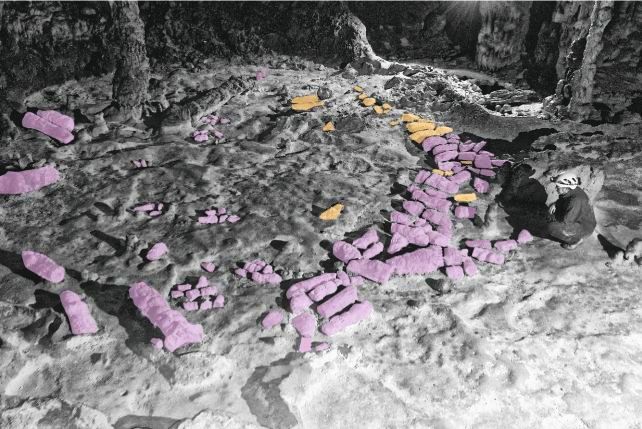Our world is riddled with fascinating, perilous, but beautiful holes into the quiet depths of the crust. To explore a cave is to meet with awe – a calm, almost alien world, far removed from the babble and busyness of the world above ground.
One of the most spectacular known cave networks in the world is the Saint-Marcel Cave in France. The entrance area has been occupied by humans for millennia, dating back to the Middle Palaeolithic.
But there's a lot more to it than the entrance. The cave extends for at least 64 kilometers (40 miles), a twisting, convoluted cavity bored through Earth's crust.
Because of its long history of habitation, it's of keen interest to anthropologists. But now, scientists led by geomorphologist Jean-Jacques Delannoy of the French National Centre for Scientific Research (CNRS) have found a puzzle.
Deep in the cave, across a hazardous path including deep pits, they have found broken stalagmites more than 1.5 kilometers (0.93 miles) past the entrance, suggesting the presence of humans – around 8,000 years ago.

Even by today's standards, which include safety gear, sophisticated equipment, and powerful lighting, the pits in the path are considered hazardous. This raises the question: how did ancient humans access the site, and get back out again?
"This discovery and the fact that the structures are around 8,000 years old is exceptional," Delannoy tells PNAS. "This raises the question of cave knowledge at that prehistoric period, their ability to explore and cross shafts, and their mastery of lighting."
The part of the cave Delannoy and his colleagues studied has been known about for some time, with a bunch of broken rock formations called speleothems littering the floor. These are mineral deposits formed by groundwater in caves, such as stalagmites (an upward-pointing formation on the cave floor) and stalactites (a downward-hanging formation on the cave ceiling).
It's not uncommon for well-known caves to have broken speleothems. It was kind of the done thing for cave explorers and tourists in the late 19th century to break off bits of rock as souvenirs, or leave marks on the cave walls to commemorate their visit. It was assumed that the broken speleothems in Saint-Marcel were the work of such tourists.

But Delannoy and his colleagues have found ancient traces of human presence in other caves, which raised questions about when, exactly, the rocks in Saint-Marcel had been disturbed.
Luckily, with rocks, there are ways we can find out, and this is what the researchers set out to do. Speleothems form from a long, ongoing interaction with water; you can break a stalagmite off at the root, but if the water continues to flow and deposit minerals, that stalagmite will regrow.
The researchers examined the regrowth on the broken formations, but that's not all. They also analyzed the ratios of uranium and thorium in the speleothems, a technique known as uranium-thorium dating. It works because uranium is water soluble, but one of its decay products, thorium, is not – so any thorium in a sample is the decay product of uranium after the mineral has precipitated.
Because the decay rate of uranium into thorium is fixed and known, scientists can look at the amount of each in the sample to determine how long it has been since the mineral formed. Using these techniques, the researchers found that the speleothems mostly formed between 125,000 and 70,000 years ago.
The team found that the earliest broken tip was around 10,000 years ago. The most recent was around 3,000 years ago. But there was another clue. A large number of the broken pieces appear to have been deliberately placed, creating a structure in the chamber. This structure, the researchers found, was created around 8,000 years ago.

There is no doubt about it, the researchers conclude. Humans were here, long before we thought they could have been, somehow navigating the dark, dangerous passage, and breaking rocks to build something. How they did so is for future work; soot deposits on the chamber walls could be a clue, if they were placed at the same time as the construction.
"The evidence for prehistoric human activity in the cave of Saint-Marcel is conclusive," they write in their paper.
"Our study results are changing the way we look at the Saint-Marcel cave network, giving them a cultural dimension linked to prehistoric use … the results from Saint-Marcel cave invite us to take a new look at these societies, their use of caves, which has hitherto been considered to be limited to the entrance areas, their engagement with deep underground landscapes, and the associated symbolic dimensions."
Their findings have been published in the Journal of Archaeological Method and Theory.
